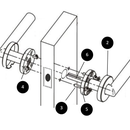Introduction: How to Get the Block Weatherboards Look With Cement Sheeting
Block weatherboard or ‘ashlar’ weatherboards we very common
on weatherboard houses across Australia. Unfortunately, as a quick google search will show, there are not many suppliers of block weatherboards and subsequently they are much more expensive than regular weatherboards.
The easy steps below will run you through how you can create block fronted weatherboards with regular cement sheeting you can get at any hardware. This will make it a much lower cost option and an even more durable option to timber boards.
Step 1: What You Require to Complete This Job
Firstly, what you’ll Need
1. Cement sheets. The number will depend on the size of the front of your house. Either 4.5mm, 5mm or 6mm thick will work perfectly. Enough to line the whole area
2. Hardiplank smooth weatherboards. These come in woodgrain or smooth. The smooth ones are the ones you want. They are really just skinny lengths of cement sheeting the perfect width for your blocks. Get the 230mm wide ones.
3. Nails or screws to fix the cement sheeting
4. Cement sheeting scoring tool, to cut the sheeting
5. Liquid nails or similar
6. Exterior no more gaps or similar
7. Weatherboard stoppers (for the corners the blocks butt up to)
Optional
1. Sisilation- if your house doesn’t already have it
2. Insulation- a great time to put insulation in your walls, again, if your house doesn’t have it
Step 2: Remove Existing
The first step is obvious. Simply remove existing weatherboards or cladding you are replacing. This is a good time to install insulation in your walls as they are unlikely to already have it. Tips on the best insulation can be obtained by a quick google search. Sisilation should then be installed which is the blue and silver wrap you may have seen on housed being built. As you can see in the pictures, this particular house had had its washboards removed and replaced with a cement render.
Step 3: Cladding First Stage
The next step is to clad the whole front of the house using the sheets of cement sheeting. Ensure the joins are on studs and all nails (or screws) are all the way in and not protruding. A second set of hands at this stage is a necessity as the sheets can be quite heavy. Cut the sheeting using the scoring tool. To use the tool find a straight piece of wood and use it as a guide to run the scoring tool across the board several times. Then put the piece of wood under the sheeting and snap the sheeting and it will break along the scoring line. Easy, once you do it a couple of times.
Step 4: Joins
Fill the joins between the fitted sheets with exterior ‘no more gaps’ or another external sealant. This is also the best time to paint the cement sheeting the final colour of your block fronted boards and it will be much easier now then trying to paint between the blocks later. The final job here is to install weatherboard stoppers in each corner. These are essentially timber pieces of wood roughly 45mm by 25mm that all weatherboards butt up to.
Step 5: Create the 'blocks'
Now to create the ‘blocks’. Essentially you cut the Hardiplank lengths into blocks the width you want the blocks to be, using the scoring tool. Blocks on weatherboard houses are normally between 480mm and 600mm wide. So to work out the best width for your house we need to do some maths. Measure the width of the section you are cladding. The blocks are separated by a 20mm gap, so experiment with some block widths and work out the correct width so you can get a row of full width blocks across the front. What you don’t want to end up with is 1/3 blocks at each end as it will not look good. Factor in the 20mm gap between the blocks, although consider you will not have a gap at the ends, so there will be one less gap across and row then there are blocks. If you’re getting confused mark it out on the cement sheeting on your house and experiment a bit.
Step 6: Attach Blocks
Work out how many blocks you need to cut the Hardiplank into. You will now know how many blocks make up one row, so you just need to work out how many rows using the 230mm board width and 20mm gap between each block vertically. Fixing the blocks is quite simple, just apply liquid nails to the back of the blocks and stick them onto the cement sheeting. Now the tricky part is keeping them from falling off whilst it dries. To do this I simply put 2 screws partially in below the blocks for them to sit on, then removed the screws later and filled the holes. You could just screw the blocks on after gluing too. Remember each row is off set so every second row is the same, as per the diagram below. So for every second row you will have a block exactly half the normal width at each end. It’s a good idea to get a 20mm wide bit of wood to site between your rows whilst attaching, to get the blocks in line.
Step 7: Finish Off
With all the blocks attached and time has been allowed for them to dry, apply exterior ‘no more gaps’ around the edges of each block where it attaches to the cement sheeting. This may seem tedious but is crucial to prevent water getting behind any gaps in the blocks and damaging them.
Finally, just paint and you’re done ! You now have a block front for a fraction of the cost and one that resistant to rot and termites!













